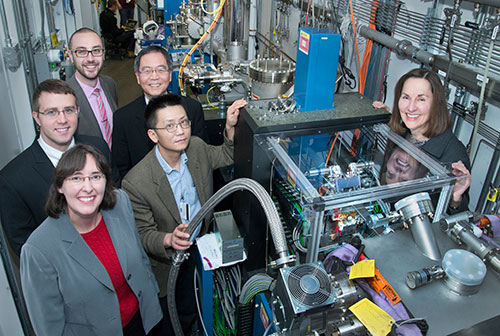- Home
-
Divisions
Energy Systems Division
- Grid Modernization and Security
- Energy Conversion
- Geothermal Materials
Energy Storage Division
- In-situ and Operando Analysis
- Vehicle Technologies
- Grid-level Storage
- Center for Mesoscale Transport Properties
- Long Island Solar Farm
- NSERC
- People
- Org Chart

Energy Storage Division
In Situ and Operando Analysis
We have expertise in mechanistic characterization of the electrochemical energy storage processes from the material level to the systems level, to elucidate productive and parasitic processes within functioning batteries.
Spatiotemporal Resolution of Phase Formation in Thick Porous Sodium Vanadium Oxide (NaV3O8) Electrodes via Operando Energy Dispersive X-ray Diffraction
Herein, zinc vanadium oxide (ZVO) and zinc hydroxy-sulfate (ZHS) formation, the discharge products in sodium vanadium oxide (NVO) cathode materials, is studied with ex situ and operando X-ray diffraction methods. Operando synchrotron-based energy dispersive X-ray diffraction (EDXRD) reveals reversible expansion of the NVO lattice due to Zn2+ insertion during discharge, spontaneous ZVO formation following cell assembly, and ZHS formation concomitant with H+ insertion at potentials less than ∼0.8 V vs Zn/Zn2+. With spatially resolved EDXRD, ZVO formation is shown to occur near the separator region first, eventually moving to the current collector region as discharge depth increases. ZHS formation, however, is found to originate from the current collector side of the positive electrode and then propagate through the porous electrode network. This study highlights the special benefits of the EDXRD method to gain mechanistic insight into structural evolution within the electrode and at its interface.
Simultaneous Elucidation of Solid and Solution Manganese Environments via Multiphase Operando Extended X-ray Absorption Fine Structure Spectroscopy in Aqueous Zn/MnO2 Batteries
Aqueous Zn/MnO2 batteries (AZMOB) hold promise as potential green grid-level energy storage solutions for clean power generation. An operando multiphase extended X-ray absorption fine structure (EXAFS) analysis was demonstrated to enable simultaneous characterization of aqueous and solid phases involved in the Mn redox reactions. Complementary Raman spectroscopy was utilized to identify the less crystalline Mn-containing products formed under charge at the cathodes. This was further augmented by transmission electron microscopy to reveal the morphology and surface condition of the deposited solids. This work demonstrates an approach toward insight into complex electrochemical mechanisms where both solid state and dissolved active materials are important contributors to redox activity.
Thermodynamic Analysis of LiNi0.6Mn0.2Co0.2O2 (NMC622) Voltage Hysteresis Induced through High Voltage Charge
High voltage charge of NMC materials can extend the initial capacity but also impair the long-term cyclability. This investigation probes NMC622 with charge limits of 4.3 and 4.7 V using operando isothermal microcalorimetry. A higher voltage charge to 4.7 V brings ∼17% increase in capacity yet a doubling of the heat dissipated compared to 4.3 V. Additionally, the thermodynamic paths of (dis)charge visualized by enthalpy potential show path-dependent (de)lithiation in the 3.0–4.7 V window. More evidence is provided explaining the long-term energy fading of NMC622 induced by high voltage, including increased thermal energy waste and asymmetric (de)lithiation thermodynamics.

The Energy Storage Division has expertise in the in situ and operando analysis of energy storage materials and systems harnessing the world-leading brightness of the National Synchrotron Light Source II (NSLS-II).





